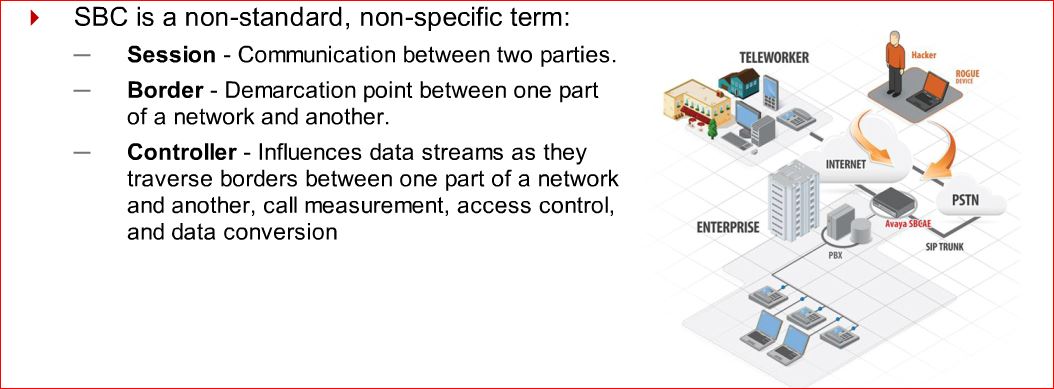The Avaya Session Border Controller for Enterprise is a flexible, fit for purpose solution for Enterprises - that includes a set of standard security features. The Avaya Session Border Controller for Enterprise provides all the functionality required for an enterprise to terminate SIP trunks without the complexity and higher price associated with typical SBCs and scales up to 2,000 simultaneous sessions per server.
Avaya SBCE provides security to SIP-based Unified Communications (UC) networks. Avaya SBCE is available in two versions: Advanced Services and Standard Services. Either version can reside on supported servers for Release 6.3.
Avaya SBCE has two main components: the Session Border Controller (Avaya SBCE) and a management system called the Element Management System (EMS).




SBCE has following features:
1.SECURITY:located at the network perimeter, it protects the enterprise data and devices by:
a)Blocking Malicious attacks in general and Denial of Service (DoS) attacks in particular
b)Preventing Toll fraud attacks based on using rogue media streams
c)Discarding Malformed packets
d)Controlling Access to the internal network
2.PRIVACY:
a)Hiding the internal network Topology (“Topology Hiding”)
b)Encrypting SIP signaling packets and/or Media packets
3.INTERPERABILITY:enables different networks to communicating by providing:
a)Network Address Translation (NAT) – substituting external IPs with internal IPs
b)Manipulation of headers within SOP messages
4.REGULATORY:provide support for:
a)Prioritizing Emergency Calls (e.g.,e911 phone calls)
b)Documenting Compliance with communication regulations
c)Enabling Law enforcement agencies to intercept telecommunications (“wire tapping”)
5.MEDIA SERVICES: Newer SBC’s have on-board digital signal processors (DSPs) for:
a) Interpreting DTMF tones and relying them as signaling messages
b)Transcoding media from one codec to another
c)Providing tones and announcements
d)Enabling reliable transmission of modern data and FAXes
e)Supporting diverse media streams such as video
6) STATISTICS and BILLING: measure the amount of traffic so that:
a)Internal Department’s can be charged based on their use of network resources
b)Determine normal baseline traffic volumes to that unusual traffic load can identified
7)DEMACRATION: Identifies which party is responsible: the SBC can be the dividing line between vendor network and customer network. Often, the Service Provider is for the SIP circuit from the provider premises. Customer is responsible for the SBC an the circuit from the internal interface.
8)TRAFFIC MANAGEMENT. Permits routing and delivery trough:
a)prioritizing traffic by assigning Quality of Service (QoS) values to packets
b) Regulating the maximum quantity of packets flowing into or out of the network
Depending on the network size and service requirement, you can deploy Avaya SBCE in one of the following configurations:
• Standalone configuration
In the standalone configuration, the Avaya SBCE and EMS coreside in the same physical server.
• Multiple server configuration
In the multiple server configuration, EMS and Avaya SBCE are deployed on separate physical servers.
• High availability (HA) configuration
In the High Availability or HA configuration, Avaya SBCE servers are deployed in pairs. Each pair has one Avaya SBCE server acting as primary while the other is secondary. Both servers are controlled by a single Avaya Element Management System (EMS) device or a replicated EMS pair.
Functional entities
Avaya SBCE security products perform security functions using three interrelated and complementary functional entities: signaling, media, and intelligence.
Previous version of Session Border Controller which might be still in use by some of the customers were:
1. Avaya Aura SBC (AASBC) – this product was the first Avaya developed SBC product. It is end of sale and manufacturer support, there might still be systems at the customers with valid maintenance support, but the number is decreasing .
2.ACME SBC – this is a 3rd party product and Avaya sold as the first SBC solution from/through Avaya. This product is end of sale, only customers with valid maintenance contract with Avaya on their ACME SBC server are eligible for maintenance support. This is 3rd party product, customers/partners may buy their ACME SBC directly from the vendor and so Avaya is not responsible for the support. It is key to ensure there is valid maintenance contract with Avaya.
Check solution link to Avaya Support website:
https://support.avaya.com/products/P0997/avaya-session-border-controller-for-enterprise/

